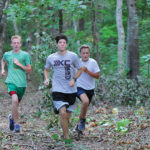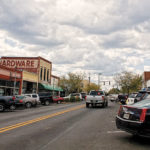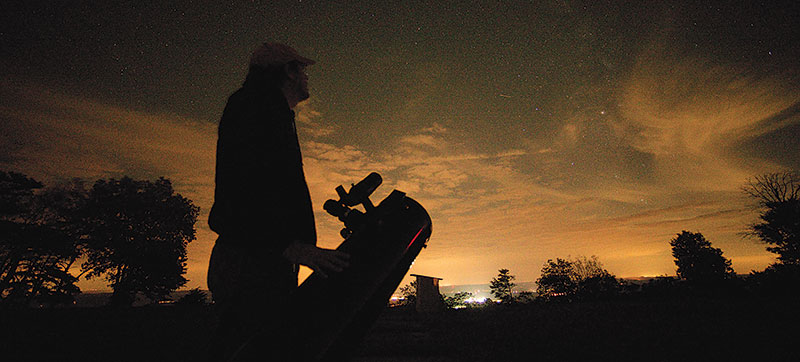
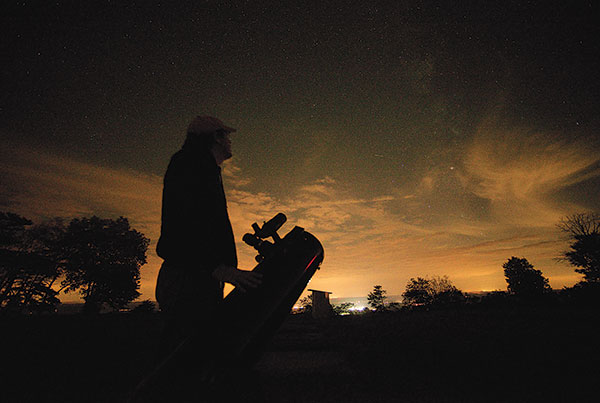
Chandler Mountain lures star gazers
Story and photos by Jim Smothers
Submitted photos
Every month members of the Birmingham Astronomical Society make their way up Chandler Mountain past Horse Pens 40 for a cliffside “Star Party” to enjoy their hobby and the company of other like-minded individuals.
Well, almost every month — if it’s cloudy, there’s always next month.
“Partly cloudy sounds like a nice forecast, but it can be an awful thing for our hobby,” said Preston Pendergraft, a club member and a security specialist with a regional banking group.
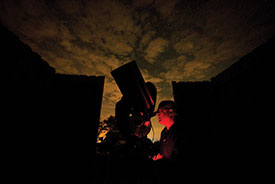 Members keep a close watch on weather forecasts and some of them use special-purpose apps that predict when the skies will be clear. They are helpful but not perfect.
Members keep a close watch on weather forecasts and some of them use special-purpose apps that predict when the skies will be clear. They are helpful but not perfect.
Saturday nights closest to new moons give the stargazers the opportunity they need to stay up late with the darkest skies of the month.
“There is lower humidity at the site, so that helps,” said Sterling Deramus, a Birmingham-based attorney and president of the club.
It also helps to get away from the light pollution in the metro-area that creates a haze they can’t see through very well.
“Dark sky is a big deal for us,” he said.
Even from Chandler Mountain, the number of security lights throughout the area is becoming more noticeable. Lights that shine into the sky collectively create a haze that makes it difficult to see objects in space, and clouds can spoil everything.
Deramus said that at some star parties there will be 20 or 30 people on the mountain with their telescopes. It’s hard to predict.
For the October outing there were only two members there. A partly cloudy sky and competition from college football may have kept others from making the trip, and Deramus’s “clear sky” app missed the mark this time — patchy clouds made for limited viewing.
Pendergraft said a public television program about the Voyager spacecraft piqued his interest in astronomy when he was a child, and he has been interested ever since. He collected golf balls from a water hazard on a golf course near his childhood home in Las Vegas and sold them to save money for his first telescope.
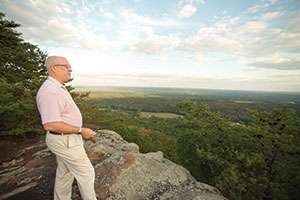 Deramus said he was interested as a kid, but it was a college class in astronomy that got him hooked.
Deramus said he was interested as a kid, but it was a college class in astronomy that got him hooked.
It’s easy to see why. The stars, planets and other objects in space hold deep connections to mankind’s past, present and future. Throughout man’s time on the planet, objects in space have stirred his imagination, with impacts not only on the understanding of the sciences and mathematics, but also on the arts, history, mythology and more.
People can enjoy astronomy as a hobby today in a number of different ways, and not all of them even involve telescopes. A simple star chart and a clear sky can be enough to start learning where and when the different constellations and planets can be seen. A pair of binoculars and a steady hand can work very well for viewing.
Some hobbyists barely look at the skies at all — an organization with a website called Zooniverse offers computer-based opportunities for amateurs to assist professionals with real-world scientific research. In astronomy, the projects include time-intensive viewing and comparison of photographs of objects in space. One project in particular is Planet Four, which involves thousands of images of Mars, and there are other astronomical studies on that site as well.
The club is active with a lecture meeting each month and two scheduled star parties — one on Chandler Mountain and another on Oak Mountain — plus outreach opportunities. Sometimes they will set up telescopes in public areas in town and invite non-members to take a look, and some of the members recently participated in a school program to introduce students to the hobby.
Lectures each month at Samford University feature a variety of speakers. One recent program featured a University of Alabama professor who spoke about galactic research, and another program was given by the Jet Propulsion Laboratory. Sometimes the lecture will be a “how-to” program to help people get more out of the time using tips and tools more effectively.
It’s all about the camaraderie, about spending time with others who share a common interest.
Party time
At a typical star party, individuals set up telescopes and seek the objects they are particularly interested in seeing. One may be looking for a particular planet.
“Saturn is a good one to see,” Deramus said.
Someone else might be trying to find separation between two stars that appear in the sky to be a single star. Others may be using photography to record deep-space galaxies. There are different goals and methods to explore the skies.
“There are different things to see in each season,” Deramus said. “There are always good things to see, good star clusters…Andromeda is a good one to find.”
Some hobbyists get started by looking for the Messier Objects, a list of about 100 bodies compiled by French astronomer Charles Messier in the 18th Century. Messier was looking for comets, and made a list of objects that look like comets — but are not — so that he could avoid spending time on them in the future. Finding and keeping a log of their locations helps hobbyists get started with learning their way around the sky.
“None of them are really that challenging to find,” Pendergraft said. “You can see a lot of them with binoculars. A lot of people go from there to the Herschel 400, which is kind of like the intermediate list. It’s a list of 400 objects that were discovered by William Herschel in the 1700s in England, and some of them were actually discovered by his sister, Caroline, as well. She was an accomplished astronomer in her own right, and she discovered some comets, too.”
Deramus uses a camera-equipped telescope to help find objects that can’t otherwise be seen. Using a series of long exposures and specific computer programs, he is able to find galaxies that can’t be seen through a telescope with the eye.
“Galaxies are a challenge,” he said. “I’ve seen some really good ones from up here, but they are very, very faint. That’s why I’m doing photography now. That was my first challenge, finding all the galaxies I wanted to see. May is the time to see galaxies because you have what’s called the Virgo and Leo clusters, which we are actually a part of — our galaxy is part of the Virgo cluster, on the outer edges of it. There are hundreds and hundreds of galaxies, it’s just amazing how many.”
Pendergraft said there is a scale for the brightness of stars and space objects. Vega is rated at 0, with higher numbers assigned on a logarithmic scale for decreasing brightness. The unaided human eye can see down to about 6, depending on the individual. With binoculars, stars down to about 9, more or less, may be seen, depending on the binoculars and how steadily they are being held. Some telescopes can extend that to 14 or 15 on a good night, and telescopes with cameras can get to 15 or 16. The Hubble telescope, by comparison, gets to 22 or 23.
“That’s probably the limit,” Deramus said.
At a typical star party, members enjoy spending time with others who share the hobby and share the excitement of seeing parts of the universe for themselves.
Some even make the trek to larger star parties in other parts of the country.
“I’ve been to one in Texas a couple of times near the McDonald Observatory,” Pendergraft said. “It’s kind of like the ‘Woodstock of Astronomy.’ Everybody who is anybody in astronomy is there.”
More places in the West have the dark sky stargazers need, and that event draws hundreds each year. It’s partly a trade show and partly a social gathering, and is a key event for hobbyists.
But there’s plenty to see from atop Chandler Mountain.
“Some people try to see the ‘Pup’,” Pendergraft said. “Everyone knows Sirius is the brightest star in the sky, but right next to it is a dimmer star everyone calls the ‘Pup.’ It was discovered in the late 1800s, not far from here, through a telescope at the University of Mississippi…there are always challenges for people to see faint objects. There are galaxies and nebulae. There are bright objects, which people want to see features inside them.
“It’s a hobby that you can take as far as you want to go, from the naked eye to custom built scopes that cost as much as your car.” l
Learn more about the Birmingham Astronomical Society at www.bas-astro.com or on Facebook at The Birmingham Astronomical Society of Alabama.











